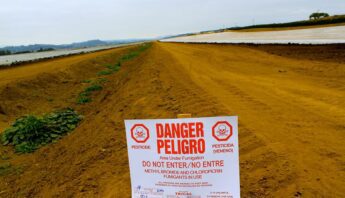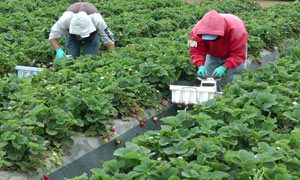Policymakers urged to support comprehensive new rules that would protect children from fumigants and other hazardous pesticides
For Immediate Release
February 18, 2016
Sacramento, California – A new report by the University of California – Los Angeles (UCLA) has shown an increase in cancer risk from fumigant pesticides frequently used in combination near schools. In response to the report’s findings, a coalition of parents, health professionals, teachers, and food advocates has urged state policymakers to create stronger protections for schoolchildren across the state.
“Pesticides used near schools mix to make an even more toxic combination,” said Sarah Aird, acting executive director of Californians for Pesticide Reform. “The real-life applications of pesticides pose significant threat, one that Department of Pesticide Regulation officials aren’t taking into account. They need to provide better protections — particularly for our most vulnerable populations.” Fumigant pesticides are difficult-to-control, highly volatile gases injected into the soil to control pests around crops like strawberries, grapes, and orchard and root crops. They can persist in the air for days and are applied together or in quick succession, yet state officials fail to consider the health risks from being exposed multiple pesticides as part of pesticide evaluations.
Over 30 million pounds of three fumigants — chloropicrin, metam salts, and Telone (1,3 – dichloropropene) — were applied in California in the last year on record (2013). According to the California Department of Public Health, they are also three of the four most widely used pesticides near California schools. The heaviest use is on the Central Coast and in the Central Valley.
The new report by researchers at the UCLA Sustainable Technology & Policy Program entitled “Exposure and Interaction: The Potential Health Impacts of Using Multiple Pesticides,” documents an increased cancer risk when any of these fumigants are used in combination. The report suggests that fumigants can each attack the body’s detoxification mechanisms, leaving the body more vulnerable to harm when exposed to another fumigant simultaneously. And that threat is particularly acute for children. Individually, these three pesticides are suspected developmental toxins, and are known carcinogens and respiratory irritants.
“We face a growing epidemic of cancer and other threats to children’s health and learning potential,” said Emily Marquez, PhD, staff scientist at PAN. “Just like prescription drugs, when used in combination pesticides can grow in potency. The only difference is that – unlike the FDA – state officials aren’t paying attention to these interactions.”
Children’s developing bodies take in more of everything. Relative to their size, kids eat, breathe and drink much more than adults. An infant takes in about 15 times more water than an adult per pound of body weight, and up to age 12, a child inhales roughly twice as much air.
UCLA researchers are also quick to point out that “interactive effects from [fumigants] and other pesticides may also increase the risk of other human health problems, including those related to developmental, reproductive, and neurotoxicity.”
Members of Californians for Pesticide Reform, a statewide coalition of more than 190 organizations, called on state officials to accept their responsibility to protect children from pesticides linked to cancer and other serious health harms. The California Department of Pesticide Regulation is mandated by the state to consider real-world exposures to pesticides. And right now, over 500,000 California schoolchildren attend schools near the heaviest and most hazardous pesticide use. A disproportionate number of those impacted are Latino children.
“State officials have failed to provide clear and comprehensive rules for pesticides used near schoolchildren,” said Claudia Angulo, a mother of a child in Tulare County, and whose child was recently found to have over 50 different pesticides in his body. “New rules should provide no spray or no- fumigation zones around schools, to reduce the risk of exposure to hazardous pesticides alone and in combination.”
Officials at the Department of Pesticide Regulation have indicated they will consider rules to restrict hazardous pesticide use near schools as early as next month. Californians for Pesticide Reform, the California Teachers Association and California Federation of Teachers are pressing for permanent one-mile no-spray zones around schools for the most hazardous pesticides, as well as additional restrictions on aerial, fumigation and air blaster applications — and better notification around proposed applications to parents and teachers.
Figure 1. Portion of Northern California fumigant pesticide use near schools

Figure 2. Portion of Southern California fumigant pesticide use near schools

Source: California Department of Public Health, 2014
A summary of the report is available English and Spanish.
Contacts:
Paul Towers, PAN/CPR, 916-216-1082, ptowers@panna.org
###
CPR is a statewide coalition of more than 190 organizations, founded in 1996 to fundamentally shift the way pesticides are used in California. CPR’s mission is to protect public health, improve environmental quality and expand a sustainable and just agriculture system by building a diverse movement across California to change statewide and local pesticide policies and practices.







